Oman Diet Plan Report: Dietary Control of Hypertension in Oman
VerifiedAdded on 2022/08/09
|17
|3956
|18
Report
AI Summary
This report examines the Oman diet plan as a strategy for hypertension prevention, a significant public health concern in the country. It explores the multifaceted nature of the issue, highlighting the increasing prevalence of hypertension and associated cardiovascular diseases. The report identifies key stakeholders, including government entities, healthcare providers, the public, and international organizations like WHO, and their respective roles in addressing hypertension. It details various interventions, such as the implementation of health policies, monitoring systems, health education programs, and the promotion of healthy lifestyles. The report also reviews existing literature, presenting nutritional statistics and health-related data, emphasizing the importance of dietary control, including consumption of whole grains, fruits, and fortified foods. Furthermore, the report discusses the existing mandates and strategies implemented by the Ministry of Health Oman and WHO's HEARTS initiative, aiming to improve the management and prevention of cardiovascular disease. The report concludes by emphasizing the need for comprehensive approaches to combat hypertension, including diet control, lifestyle modifications, and ongoing monitoring.
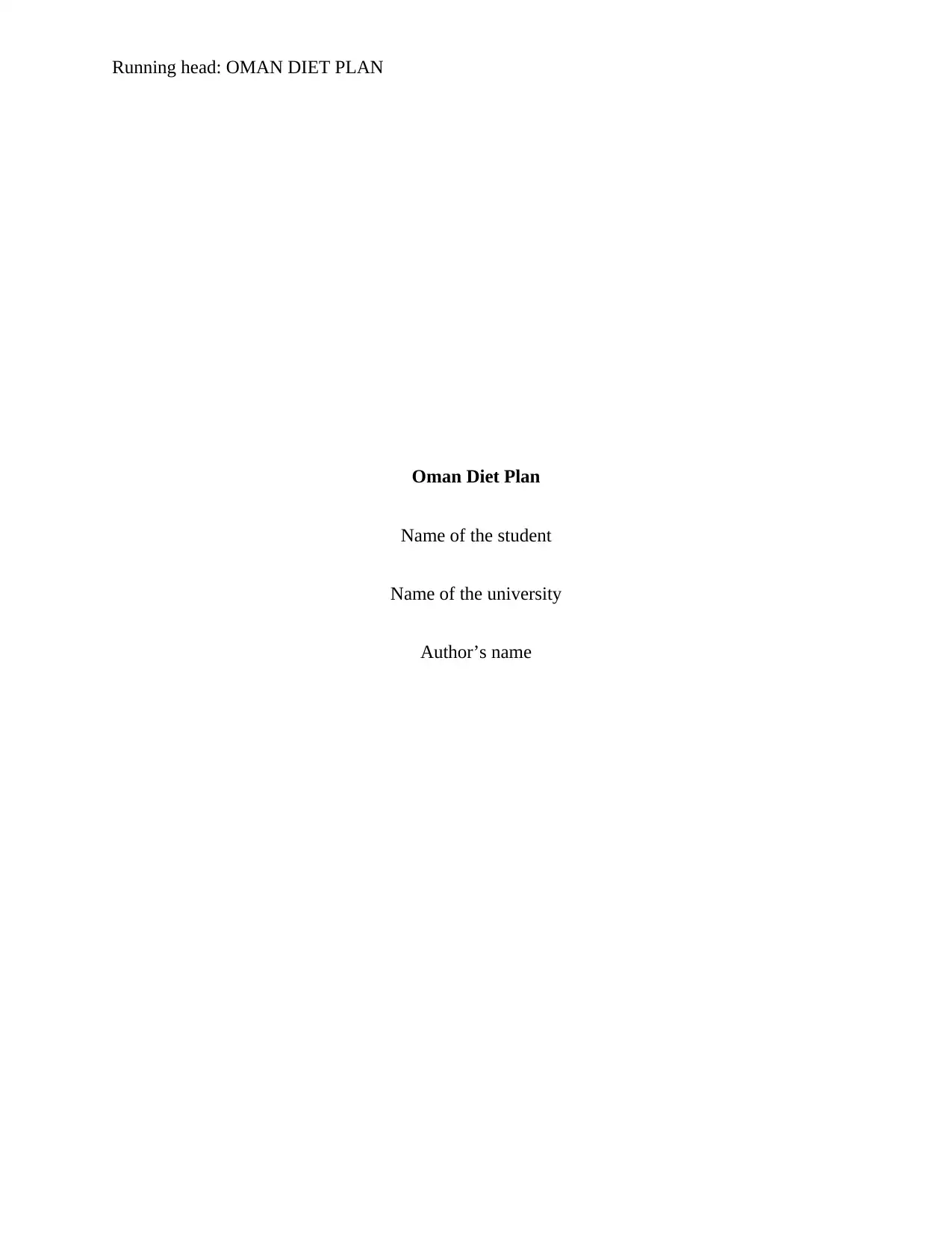
Running head: OMAN DIET PLAN
Oman Diet Plan
Name of the student
Name of the university
Author’s name
Oman Diet Plan
Name of the student
Name of the university
Author’s name
Paraphrase This Document
Need a fresh take? Get an instant paraphrase of this document with our AI Paraphraser
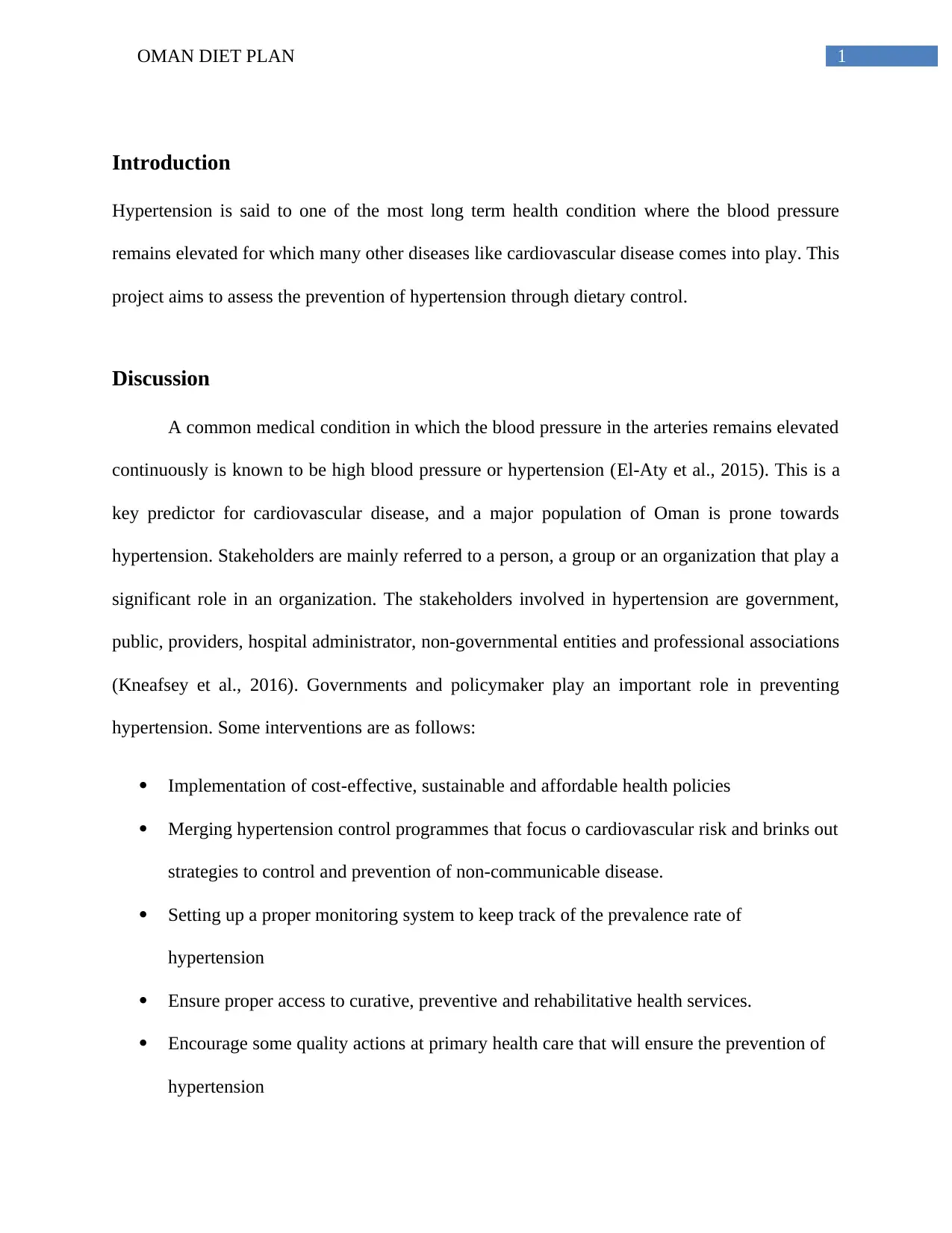
1OMAN DIET PLAN
Introduction
Hypertension is said to one of the most long term health condition where the blood pressure
remains elevated for which many other diseases like cardiovascular disease comes into play. This
project aims to assess the prevention of hypertension through dietary control.
Discussion
A common medical condition in which the blood pressure in the arteries remains elevated
continuously is known to be high blood pressure or hypertension (El-Aty et al., 2015). This is a
key predictor for cardiovascular disease, and a major population of Oman is prone towards
hypertension. Stakeholders are mainly referred to a person, a group or an organization that play a
significant role in an organization. The stakeholders involved in hypertension are government,
public, providers, hospital administrator, non-governmental entities and professional associations
(Kneafsey et al., 2016). Governments and policymaker play an important role in preventing
hypertension. Some interventions are as follows:
Implementation of cost-effective, sustainable and affordable health policies
Merging hypertension control programmes that focus o cardiovascular risk and brinks out
strategies to control and prevention of non-communicable disease.
Setting up a proper monitoring system to keep track of the prevalence rate of
hypertension
Ensure proper access to curative, preventive and rehabilitative health services.
Encourage some quality actions at primary health care that will ensure the prevention of
hypertension
Introduction
Hypertension is said to one of the most long term health condition where the blood pressure
remains elevated for which many other diseases like cardiovascular disease comes into play. This
project aims to assess the prevention of hypertension through dietary control.
Discussion
A common medical condition in which the blood pressure in the arteries remains elevated
continuously is known to be high blood pressure or hypertension (El-Aty et al., 2015). This is a
key predictor for cardiovascular disease, and a major population of Oman is prone towards
hypertension. Stakeholders are mainly referred to a person, a group or an organization that play a
significant role in an organization. The stakeholders involved in hypertension are government,
public, providers, hospital administrator, non-governmental entities and professional associations
(Kneafsey et al., 2016). Governments and policymaker play an important role in preventing
hypertension. Some interventions are as follows:
Implementation of cost-effective, sustainable and affordable health policies
Merging hypertension control programmes that focus o cardiovascular risk and brinks out
strategies to control and prevention of non-communicable disease.
Setting up a proper monitoring system to keep track of the prevalence rate of
hypertension
Ensure proper access to curative, preventive and rehabilitative health services.
Encourage some quality actions at primary health care that will ensure the prevention of
hypertension
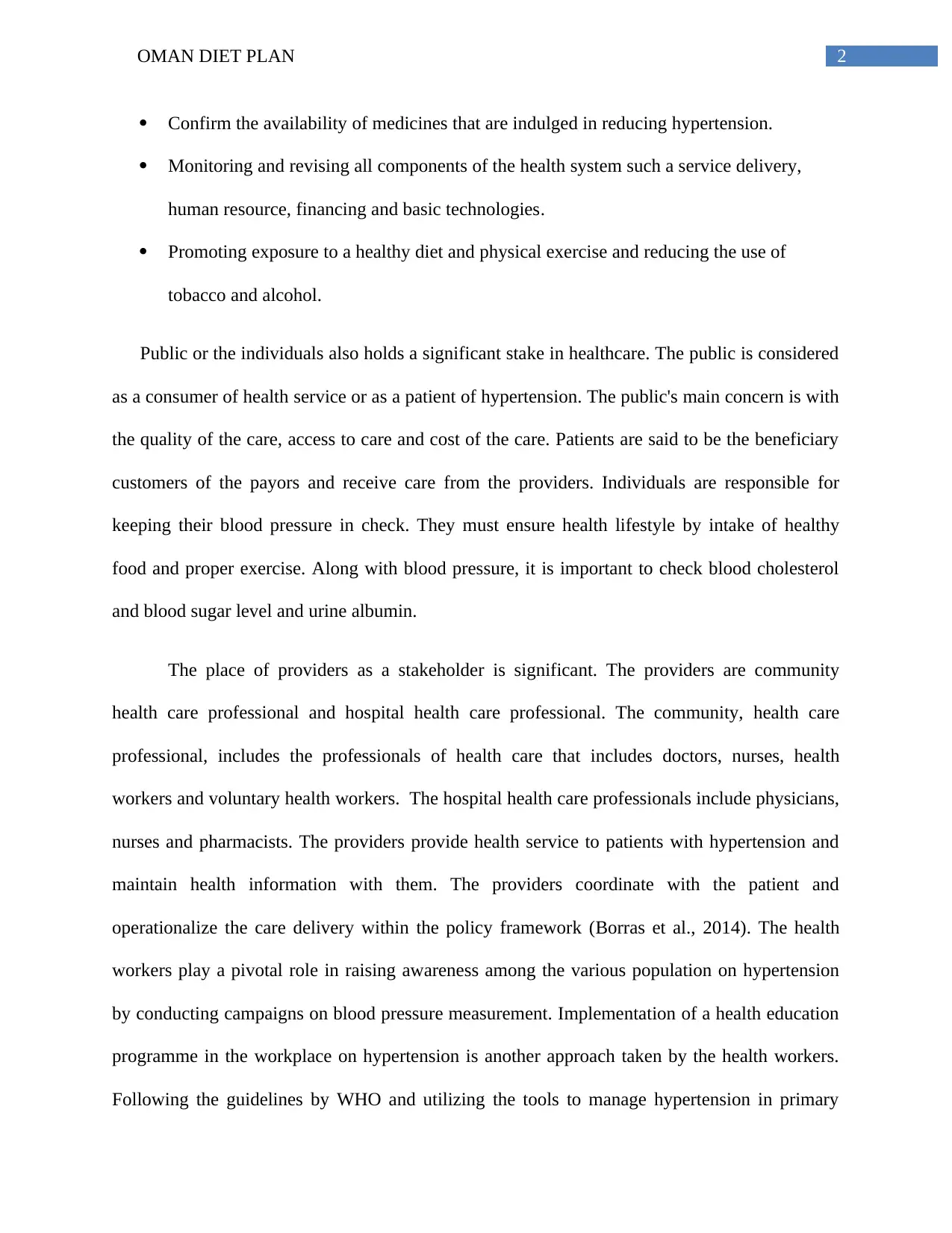
2OMAN DIET PLAN
Confirm the availability of medicines that are indulged in reducing hypertension.
Monitoring and revising all components of the health system such a service delivery,
human resource, financing and basic technologies.
Promoting exposure to a healthy diet and physical exercise and reducing the use of
tobacco and alcohol.
Public or the individuals also holds a significant stake in healthcare. The public is considered
as a consumer of health service or as a patient of hypertension. The public's main concern is with
the quality of the care, access to care and cost of the care. Patients are said to be the beneficiary
customers of the payors and receive care from the providers. Individuals are responsible for
keeping their blood pressure in check. They must ensure health lifestyle by intake of healthy
food and proper exercise. Along with blood pressure, it is important to check blood cholesterol
and blood sugar level and urine albumin.
The place of providers as a stakeholder is significant. The providers are community
health care professional and hospital health care professional. The community, health care
professional, includes the professionals of health care that includes doctors, nurses, health
workers and voluntary health workers. The hospital health care professionals include physicians,
nurses and pharmacists. The providers provide health service to patients with hypertension and
maintain health information with them. The providers coordinate with the patient and
operationalize the care delivery within the policy framework (Borras et al., 2014). The health
workers play a pivotal role in raising awareness among the various population on hypertension
by conducting campaigns on blood pressure measurement. Implementation of a health education
programme in the workplace on hypertension is another approach taken by the health workers.
Following the guidelines by WHO and utilizing the tools to manage hypertension in primary
Confirm the availability of medicines that are indulged in reducing hypertension.
Monitoring and revising all components of the health system such a service delivery,
human resource, financing and basic technologies.
Promoting exposure to a healthy diet and physical exercise and reducing the use of
tobacco and alcohol.
Public or the individuals also holds a significant stake in healthcare. The public is considered
as a consumer of health service or as a patient of hypertension. The public's main concern is with
the quality of the care, access to care and cost of the care. Patients are said to be the beneficiary
customers of the payors and receive care from the providers. Individuals are responsible for
keeping their blood pressure in check. They must ensure health lifestyle by intake of healthy
food and proper exercise. Along with blood pressure, it is important to check blood cholesterol
and blood sugar level and urine albumin.
The place of providers as a stakeholder is significant. The providers are community
health care professional and hospital health care professional. The community, health care
professional, includes the professionals of health care that includes doctors, nurses, health
workers and voluntary health workers. The hospital health care professionals include physicians,
nurses and pharmacists. The providers provide health service to patients with hypertension and
maintain health information with them. The providers coordinate with the patient and
operationalize the care delivery within the policy framework (Borras et al., 2014). The health
workers play a pivotal role in raising awareness among the various population on hypertension
by conducting campaigns on blood pressure measurement. Implementation of a health education
programme in the workplace on hypertension is another approach taken by the health workers.
Following the guidelines by WHO and utilizing the tools to manage hypertension in primary
⊘ This is a preview!⊘
Do you want full access?
Subscribe today to unlock all pages.

Trusted by 1+ million students worldwide
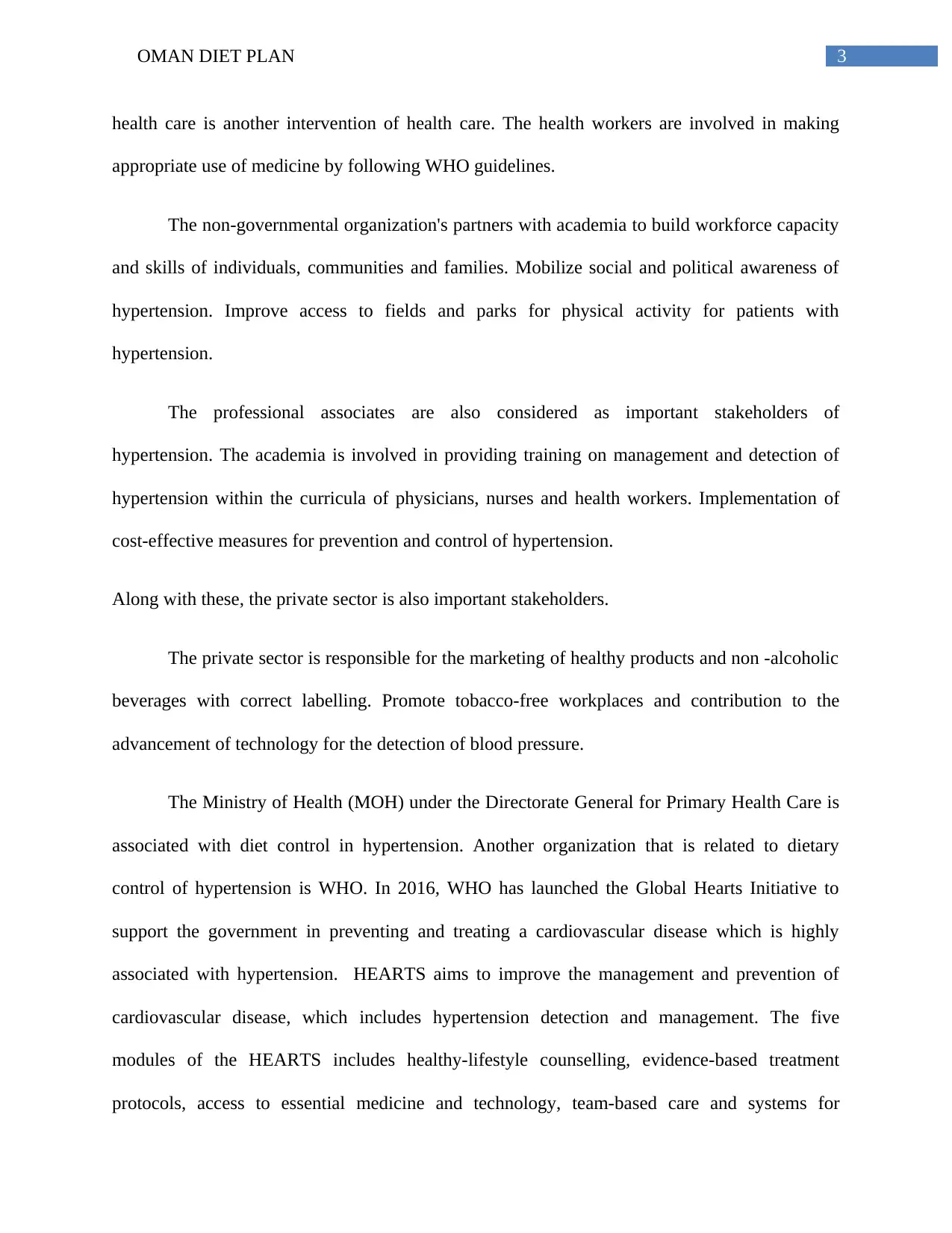
3OMAN DIET PLAN
health care is another intervention of health care. The health workers are involved in making
appropriate use of medicine by following WHO guidelines.
The non-governmental organization's partners with academia to build workforce capacity
and skills of individuals, communities and families. Mobilize social and political awareness of
hypertension. Improve access to fields and parks for physical activity for patients with
hypertension.
The professional associates are also considered as important stakeholders of
hypertension. The academia is involved in providing training on management and detection of
hypertension within the curricula of physicians, nurses and health workers. Implementation of
cost-effective measures for prevention and control of hypertension.
Along with these, the private sector is also important stakeholders.
The private sector is responsible for the marketing of healthy products and non -alcoholic
beverages with correct labelling. Promote tobacco-free workplaces and contribution to the
advancement of technology for the detection of blood pressure.
The Ministry of Health (MOH) under the Directorate General for Primary Health Care is
associated with diet control in hypertension. Another organization that is related to dietary
control of hypertension is WHO. In 2016, WHO has launched the Global Hearts Initiative to
support the government in preventing and treating a cardiovascular disease which is highly
associated with hypertension. HEARTS aims to improve the management and prevention of
cardiovascular disease, which includes hypertension detection and management. The five
modules of the HEARTS includes healthy-lifestyle counselling, evidence-based treatment
protocols, access to essential medicine and technology, team-based care and systems for
health care is another intervention of health care. The health workers are involved in making
appropriate use of medicine by following WHO guidelines.
The non-governmental organization's partners with academia to build workforce capacity
and skills of individuals, communities and families. Mobilize social and political awareness of
hypertension. Improve access to fields and parks for physical activity for patients with
hypertension.
The professional associates are also considered as important stakeholders of
hypertension. The academia is involved in providing training on management and detection of
hypertension within the curricula of physicians, nurses and health workers. Implementation of
cost-effective measures for prevention and control of hypertension.
Along with these, the private sector is also important stakeholders.
The private sector is responsible for the marketing of healthy products and non -alcoholic
beverages with correct labelling. Promote tobacco-free workplaces and contribution to the
advancement of technology for the detection of blood pressure.
The Ministry of Health (MOH) under the Directorate General for Primary Health Care is
associated with diet control in hypertension. Another organization that is related to dietary
control of hypertension is WHO. In 2016, WHO has launched the Global Hearts Initiative to
support the government in preventing and treating a cardiovascular disease which is highly
associated with hypertension. HEARTS aims to improve the management and prevention of
cardiovascular disease, which includes hypertension detection and management. The five
modules of the HEARTS includes healthy-lifestyle counselling, evidence-based treatment
protocols, access to essential medicine and technology, team-based care and systems for
Paraphrase This Document
Need a fresh take? Get an instant paraphrase of this document with our AI Paraphraser
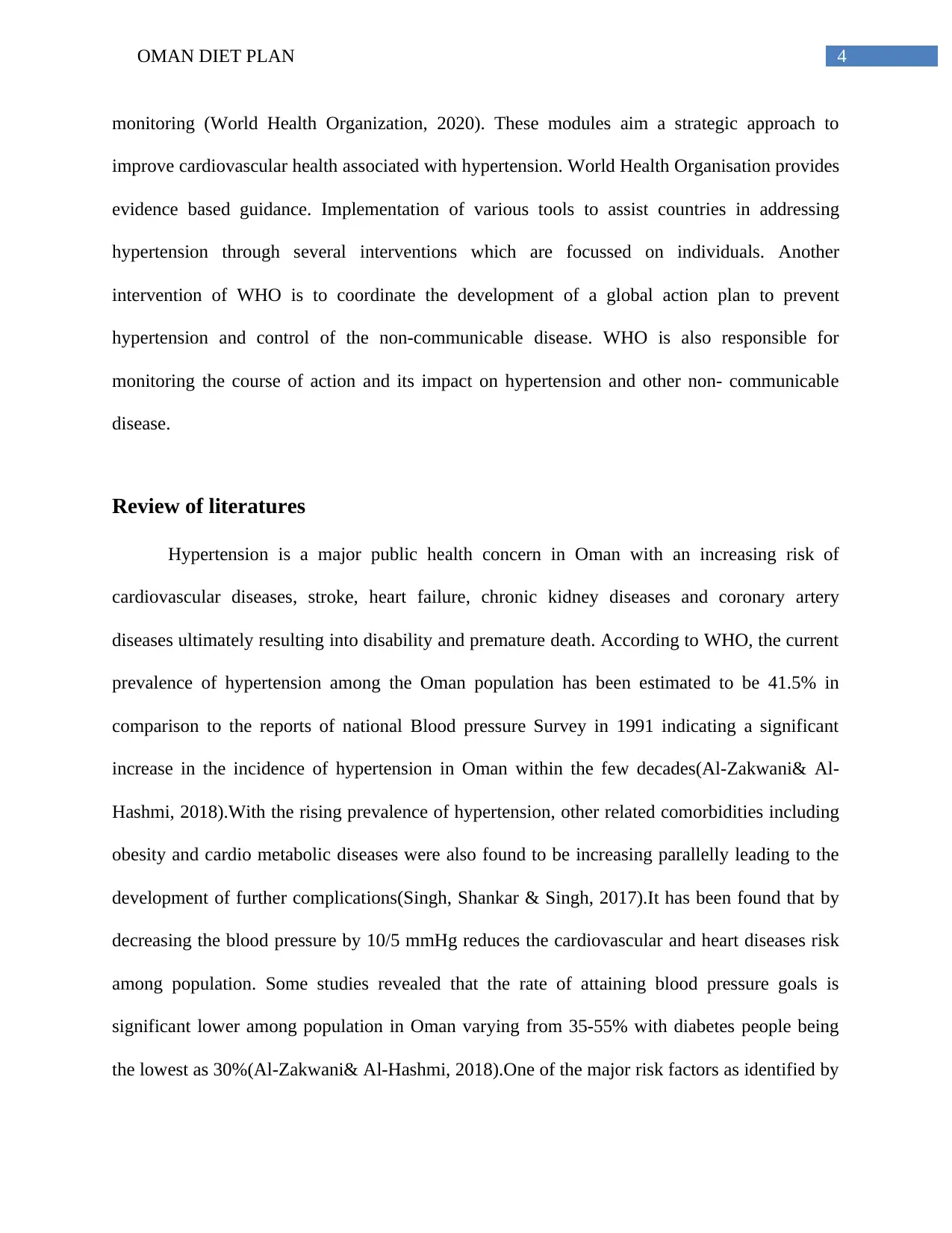
4OMAN DIET PLAN
monitoring (World Health Organization, 2020). These modules aim a strategic approach to
improve cardiovascular health associated with hypertension. World Health Organisation provides
evidence based guidance. Implementation of various tools to assist countries in addressing
hypertension through several interventions which are focussed on individuals. Another
intervention of WHO is to coordinate the development of a global action plan to prevent
hypertension and control of the non-communicable disease. WHO is also responsible for
monitoring the course of action and its impact on hypertension and other non- communicable
disease.
Review of literatures
Hypertension is a major public health concern in Oman with an increasing risk of
cardiovascular diseases, stroke, heart failure, chronic kidney diseases and coronary artery
diseases ultimately resulting into disability and premature death. According to WHO, the current
prevalence of hypertension among the Oman population has been estimated to be 41.5% in
comparison to the reports of national Blood pressure Survey in 1991 indicating a significant
increase in the incidence of hypertension in Oman within the few decades(Al-Zakwani& Al-
Hashmi, 2018).With the rising prevalence of hypertension, other related comorbidities including
obesity and cardio metabolic diseases were also found to be increasing parallelly leading to the
development of further complications(Singh, Shankar & Singh, 2017).It has been found that by
decreasing the blood pressure by 10/5 mmHg reduces the cardiovascular and heart diseases risk
among population. Some studies revealed that the rate of attaining blood pressure goals is
significant lower among population in Oman varying from 35-55% with diabetes people being
the lowest as 30%(Al-Zakwani& Al-Hashmi, 2018).One of the major risk factors as identified by
monitoring (World Health Organization, 2020). These modules aim a strategic approach to
improve cardiovascular health associated with hypertension. World Health Organisation provides
evidence based guidance. Implementation of various tools to assist countries in addressing
hypertension through several interventions which are focussed on individuals. Another
intervention of WHO is to coordinate the development of a global action plan to prevent
hypertension and control of the non-communicable disease. WHO is also responsible for
monitoring the course of action and its impact on hypertension and other non- communicable
disease.
Review of literatures
Hypertension is a major public health concern in Oman with an increasing risk of
cardiovascular diseases, stroke, heart failure, chronic kidney diseases and coronary artery
diseases ultimately resulting into disability and premature death. According to WHO, the current
prevalence of hypertension among the Oman population has been estimated to be 41.5% in
comparison to the reports of national Blood pressure Survey in 1991 indicating a significant
increase in the incidence of hypertension in Oman within the few decades(Al-Zakwani& Al-
Hashmi, 2018).With the rising prevalence of hypertension, other related comorbidities including
obesity and cardio metabolic diseases were also found to be increasing parallelly leading to the
development of further complications(Singh, Shankar & Singh, 2017).It has been found that by
decreasing the blood pressure by 10/5 mmHg reduces the cardiovascular and heart diseases risk
among population. Some studies revealed that the rate of attaining blood pressure goals is
significant lower among population in Oman varying from 35-55% with diabetes people being
the lowest as 30%(Al-Zakwani& Al-Hashmi, 2018).One of the major risk factors as identified by
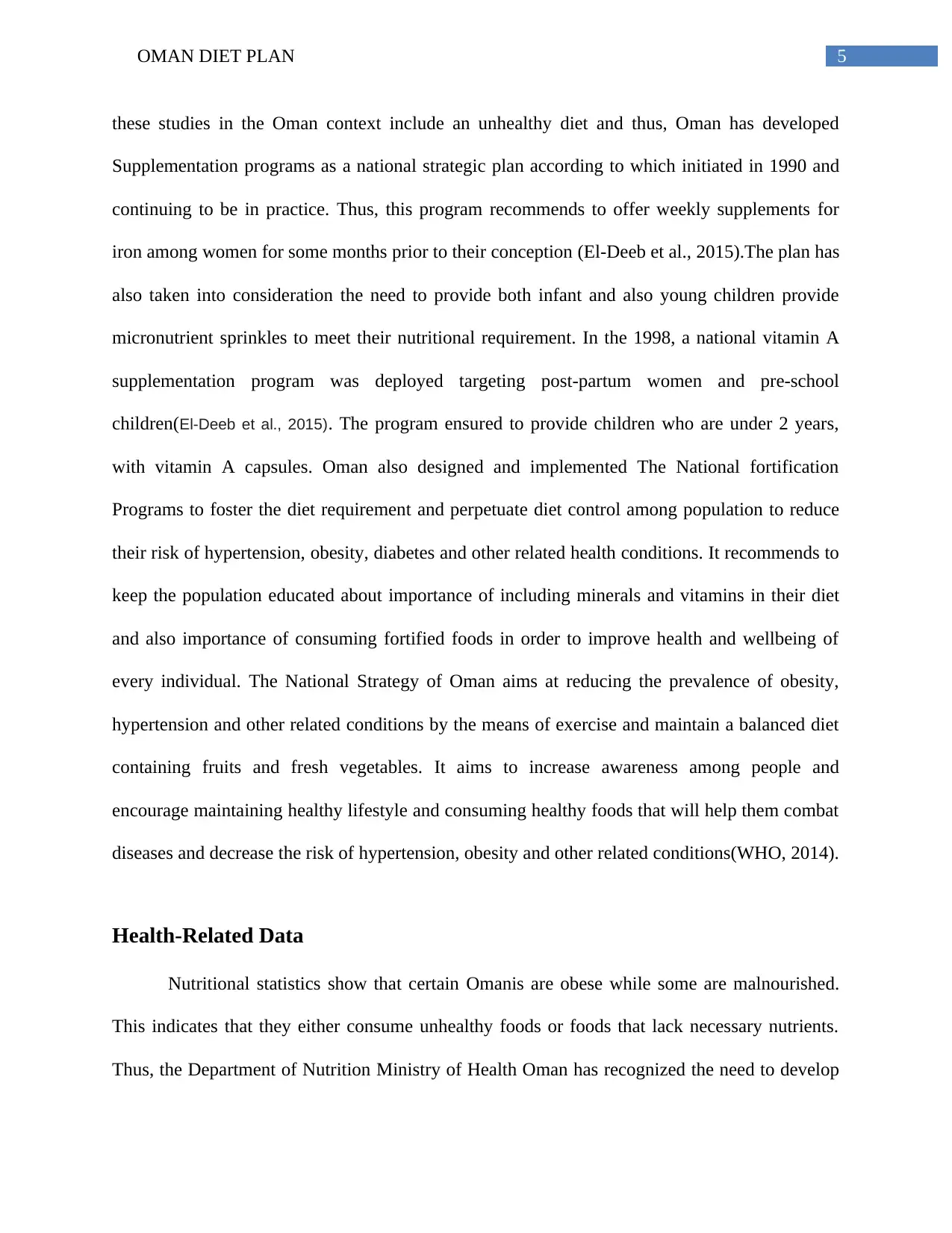
5OMAN DIET PLAN
these studies in the Oman context include an unhealthy diet and thus, Oman has developed
Supplementation programs as a national strategic plan according to which initiated in 1990 and
continuing to be in practice. Thus, this program recommends to offer weekly supplements for
iron among women for some months prior to their conception (El-Deeb et al., 2015).The plan has
also taken into consideration the need to provide both infant and also young children provide
micronutrient sprinkles to meet their nutritional requirement. In the 1998, a national vitamin A
supplementation program was deployed targeting post-partum women and pre-school
children(El-Deeb et al., 2015). The program ensured to provide children who are under 2 years,
with vitamin A capsules. Oman also designed and implemented The National fortification
Programs to foster the diet requirement and perpetuate diet control among population to reduce
their risk of hypertension, obesity, diabetes and other related health conditions. It recommends to
keep the population educated about importance of including minerals and vitamins in their diet
and also importance of consuming fortified foods in order to improve health and wellbeing of
every individual. The National Strategy of Oman aims at reducing the prevalence of obesity,
hypertension and other related conditions by the means of exercise and maintain a balanced diet
containing fruits and fresh vegetables. It aims to increase awareness among people and
encourage maintaining healthy lifestyle and consuming healthy foods that will help them combat
diseases and decrease the risk of hypertension, obesity and other related conditions(WHO, 2014).
Health-Related Data
Nutritional statistics show that certain Omanis are obese while some are malnourished.
This indicates that they either consume unhealthy foods or foods that lack necessary nutrients.
Thus, the Department of Nutrition Ministry of Health Oman has recognized the need to develop
these studies in the Oman context include an unhealthy diet and thus, Oman has developed
Supplementation programs as a national strategic plan according to which initiated in 1990 and
continuing to be in practice. Thus, this program recommends to offer weekly supplements for
iron among women for some months prior to their conception (El-Deeb et al., 2015).The plan has
also taken into consideration the need to provide both infant and also young children provide
micronutrient sprinkles to meet their nutritional requirement. In the 1998, a national vitamin A
supplementation program was deployed targeting post-partum women and pre-school
children(El-Deeb et al., 2015). The program ensured to provide children who are under 2 years,
with vitamin A capsules. Oman also designed and implemented The National fortification
Programs to foster the diet requirement and perpetuate diet control among population to reduce
their risk of hypertension, obesity, diabetes and other related health conditions. It recommends to
keep the population educated about importance of including minerals and vitamins in their diet
and also importance of consuming fortified foods in order to improve health and wellbeing of
every individual. The National Strategy of Oman aims at reducing the prevalence of obesity,
hypertension and other related conditions by the means of exercise and maintain a balanced diet
containing fruits and fresh vegetables. It aims to increase awareness among people and
encourage maintaining healthy lifestyle and consuming healthy foods that will help them combat
diseases and decrease the risk of hypertension, obesity and other related conditions(WHO, 2014).
Health-Related Data
Nutritional statistics show that certain Omanis are obese while some are malnourished.
This indicates that they either consume unhealthy foods or foods that lack necessary nutrients.
Thus, the Department of Nutrition Ministry of Health Oman has recognized the need to develop
⊘ This is a preview!⊘
Do you want full access?
Subscribe today to unlock all pages.

Trusted by 1+ million students worldwide
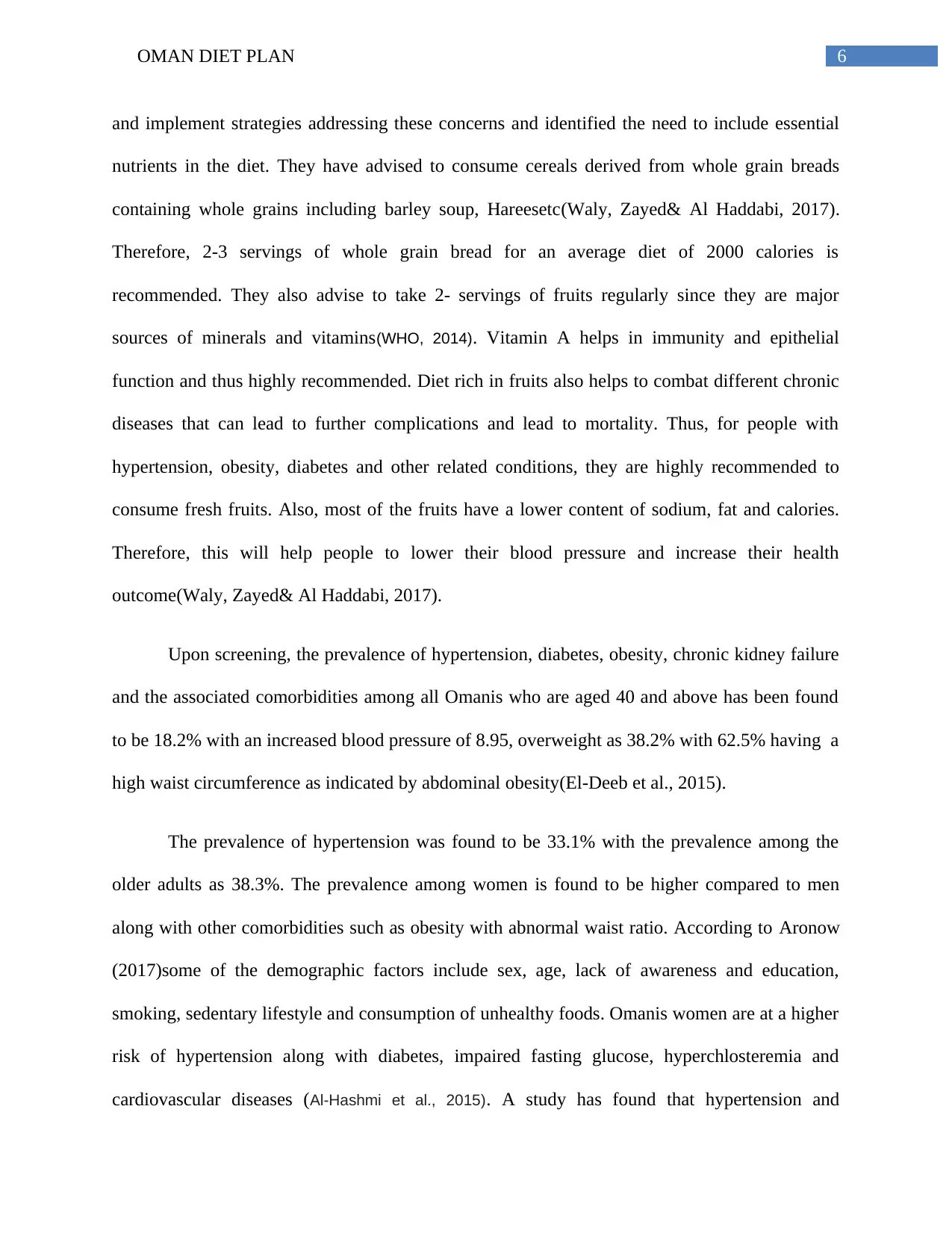
6OMAN DIET PLAN
and implement strategies addressing these concerns and identified the need to include essential
nutrients in the diet. They have advised to consume cereals derived from whole grain breads
containing whole grains including barley soup, Hareesetc(Waly, Zayed& Al Haddabi, 2017).
Therefore, 2-3 servings of whole grain bread for an average diet of 2000 calories is
recommended. They also advise to take 2- servings of fruits regularly since they are major
sources of minerals and vitamins(WHO, 2014). Vitamin A helps in immunity and epithelial
function and thus highly recommended. Diet rich in fruits also helps to combat different chronic
diseases that can lead to further complications and lead to mortality. Thus, for people with
hypertension, obesity, diabetes and other related conditions, they are highly recommended to
consume fresh fruits. Also, most of the fruits have a lower content of sodium, fat and calories.
Therefore, this will help people to lower their blood pressure and increase their health
outcome(Waly, Zayed& Al Haddabi, 2017).
Upon screening, the prevalence of hypertension, diabetes, obesity, chronic kidney failure
and the associated comorbidities among all Omanis who are aged 40 and above has been found
to be 18.2% with an increased blood pressure of 8.95, overweight as 38.2% with 62.5% having a
high waist circumference as indicated by abdominal obesity(El-Deeb et al., 2015).
The prevalence of hypertension was found to be 33.1% with the prevalence among the
older adults as 38.3%. The prevalence among women is found to be higher compared to men
along with other comorbidities such as obesity with abnormal waist ratio. According to Aronow
(2017)some of the demographic factors include sex, age, lack of awareness and education,
smoking, sedentary lifestyle and consumption of unhealthy foods. Omanis women are at a higher
risk of hypertension along with diabetes, impaired fasting glucose, hyperchlosteremia and
cardiovascular diseases (Al-Hashmi et al., 2015). A study has found that hypertension and
and implement strategies addressing these concerns and identified the need to include essential
nutrients in the diet. They have advised to consume cereals derived from whole grain breads
containing whole grains including barley soup, Hareesetc(Waly, Zayed& Al Haddabi, 2017).
Therefore, 2-3 servings of whole grain bread for an average diet of 2000 calories is
recommended. They also advise to take 2- servings of fruits regularly since they are major
sources of minerals and vitamins(WHO, 2014). Vitamin A helps in immunity and epithelial
function and thus highly recommended. Diet rich in fruits also helps to combat different chronic
diseases that can lead to further complications and lead to mortality. Thus, for people with
hypertension, obesity, diabetes and other related conditions, they are highly recommended to
consume fresh fruits. Also, most of the fruits have a lower content of sodium, fat and calories.
Therefore, this will help people to lower their blood pressure and increase their health
outcome(Waly, Zayed& Al Haddabi, 2017).
Upon screening, the prevalence of hypertension, diabetes, obesity, chronic kidney failure
and the associated comorbidities among all Omanis who are aged 40 and above has been found
to be 18.2% with an increased blood pressure of 8.95, overweight as 38.2% with 62.5% having a
high waist circumference as indicated by abdominal obesity(El-Deeb et al., 2015).
The prevalence of hypertension was found to be 33.1% with the prevalence among the
older adults as 38.3%. The prevalence among women is found to be higher compared to men
along with other comorbidities such as obesity with abnormal waist ratio. According to Aronow
(2017)some of the demographic factors include sex, age, lack of awareness and education,
smoking, sedentary lifestyle and consumption of unhealthy foods. Omanis women are at a higher
risk of hypertension along with diabetes, impaired fasting glucose, hyperchlosteremia and
cardiovascular diseases (Al-Hashmi et al., 2015). A study has found that hypertension and
Paraphrase This Document
Need a fresh take? Get an instant paraphrase of this document with our AI Paraphraser
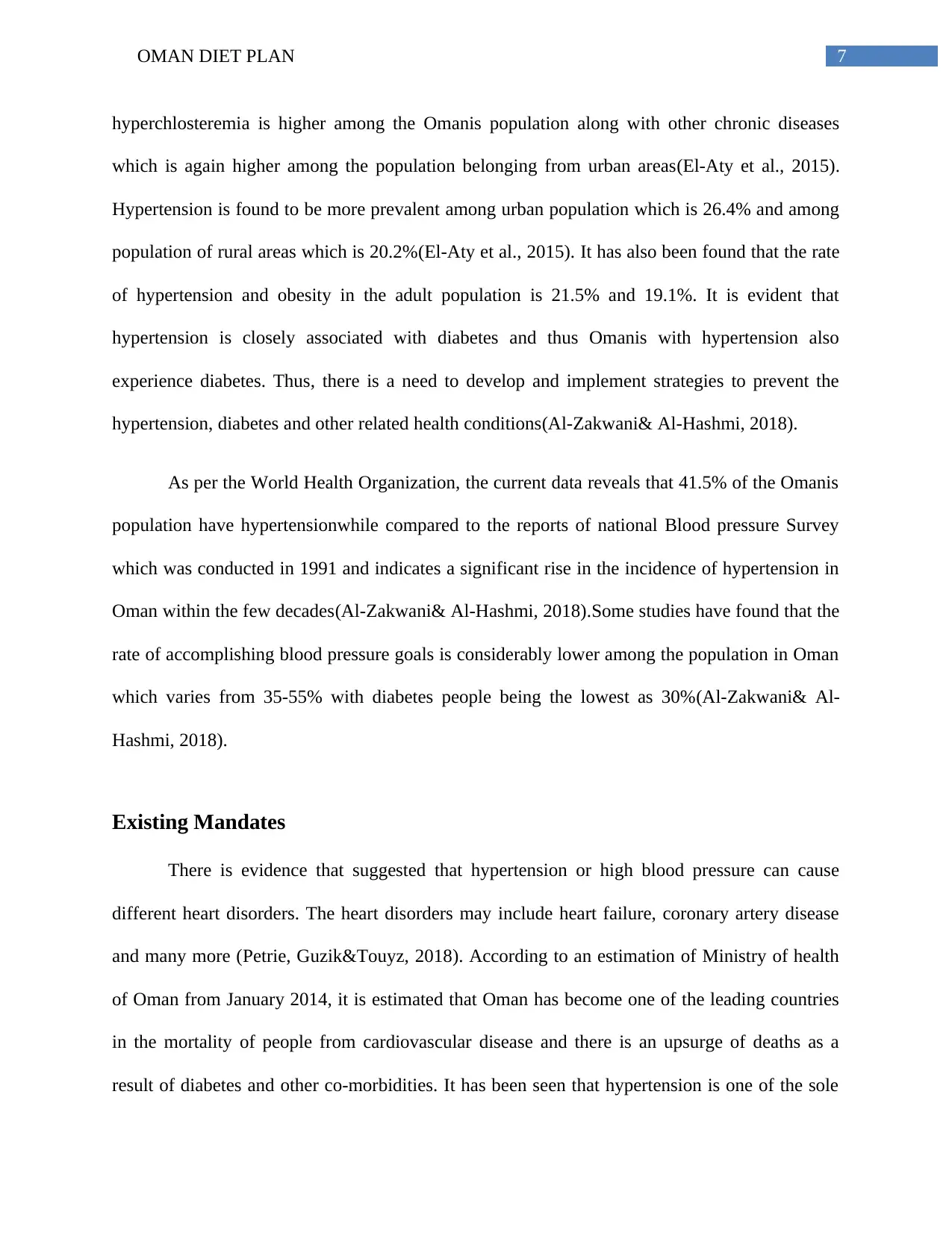
7OMAN DIET PLAN
hyperchlosteremia is higher among the Omanis population along with other chronic diseases
which is again higher among the population belonging from urban areas(El-Aty et al., 2015).
Hypertension is found to be more prevalent among urban population which is 26.4% and among
population of rural areas which is 20.2%(El-Aty et al., 2015). It has also been found that the rate
of hypertension and obesity in the adult population is 21.5% and 19.1%. It is evident that
hypertension is closely associated with diabetes and thus Omanis with hypertension also
experience diabetes. Thus, there is a need to develop and implement strategies to prevent the
hypertension, diabetes and other related health conditions(Al-Zakwani& Al-Hashmi, 2018).
As per the World Health Organization, the current data reveals that 41.5% of the Omanis
population have hypertensionwhile compared to the reports of national Blood pressure Survey
which was conducted in 1991 and indicates a significant rise in the incidence of hypertension in
Oman within the few decades(Al-Zakwani& Al-Hashmi, 2018).Some studies have found that the
rate of accomplishing blood pressure goals is considerably lower among the population in Oman
which varies from 35-55% with diabetes people being the lowest as 30%(Al-Zakwani& Al-
Hashmi, 2018).
Existing Mandates
There is evidence that suggested that hypertension or high blood pressure can cause
different heart disorders. The heart disorders may include heart failure, coronary artery disease
and many more (Petrie, Guzik&Touyz, 2018). According to an estimation of Ministry of health
of Oman from January 2014, it is estimated that Oman has become one of the leading countries
in the mortality of people from cardiovascular disease and there is an upsurge of deaths as a
result of diabetes and other co-morbidities. It has been seen that hypertension is one of the sole
hyperchlosteremia is higher among the Omanis population along with other chronic diseases
which is again higher among the population belonging from urban areas(El-Aty et al., 2015).
Hypertension is found to be more prevalent among urban population which is 26.4% and among
population of rural areas which is 20.2%(El-Aty et al., 2015). It has also been found that the rate
of hypertension and obesity in the adult population is 21.5% and 19.1%. It is evident that
hypertension is closely associated with diabetes and thus Omanis with hypertension also
experience diabetes. Thus, there is a need to develop and implement strategies to prevent the
hypertension, diabetes and other related health conditions(Al-Zakwani& Al-Hashmi, 2018).
As per the World Health Organization, the current data reveals that 41.5% of the Omanis
population have hypertensionwhile compared to the reports of national Blood pressure Survey
which was conducted in 1991 and indicates a significant rise in the incidence of hypertension in
Oman within the few decades(Al-Zakwani& Al-Hashmi, 2018).Some studies have found that the
rate of accomplishing blood pressure goals is considerably lower among the population in Oman
which varies from 35-55% with diabetes people being the lowest as 30%(Al-Zakwani& Al-
Hashmi, 2018).
Existing Mandates
There is evidence that suggested that hypertension or high blood pressure can cause
different heart disorders. The heart disorders may include heart failure, coronary artery disease
and many more (Petrie, Guzik&Touyz, 2018). According to an estimation of Ministry of health
of Oman from January 2014, it is estimated that Oman has become one of the leading countries
in the mortality of people from cardiovascular disease and there is an upsurge of deaths as a
result of diabetes and other co-morbidities. It has been seen that hypertension is one of the sole
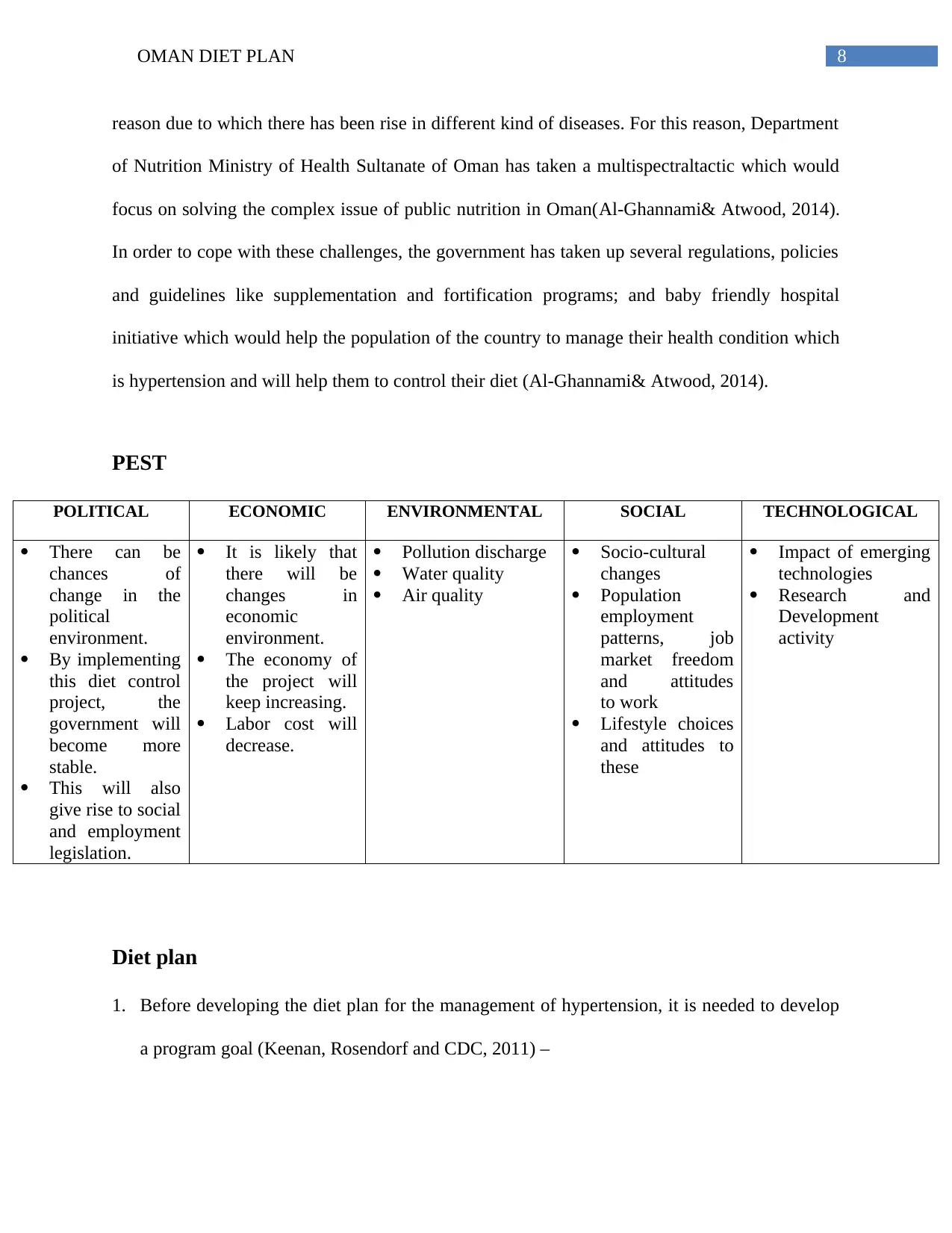
8OMAN DIET PLAN
reason due to which there has been rise in different kind of diseases. For this reason, Department
of Nutrition Ministry of Health Sultanate of Oman has taken a multispectraltactic which would
focus on solving the complex issue of public nutrition in Oman(Al-Ghannami& Atwood, 2014).
In order to cope with these challenges, the government has taken up several regulations, policies
and guidelines like supplementation and fortification programs; and baby friendly hospital
initiative which would help the population of the country to manage their health condition which
is hypertension and will help them to control their diet (Al-Ghannami& Atwood, 2014).
PEST
POLITICAL ECONOMIC ENVIRONMENTAL SOCIAL TECHNOLOGICAL
There can be
chances of
change in the
political
environment.
By implementing
this diet control
project, the
government will
become more
stable.
This will also
give rise to social
and employment
legislation.
It is likely that
there will be
changes in
economic
environment.
The economy of
the project will
keep increasing.
Labor cost will
decrease.
Pollution discharge
Water quality
Air quality
Socio-cultural
changes
Population
employment
patterns, job
market freedom
and attitudes
to work
Lifestyle choices
and attitudes to
these
Impact of emerging
technologies
Research and
Development
activity
Diet plan
1. Before developing the diet plan for the management of hypertension, it is needed to develop
a program goal (Keenan, Rosendorf and CDC, 2011) –
reason due to which there has been rise in different kind of diseases. For this reason, Department
of Nutrition Ministry of Health Sultanate of Oman has taken a multispectraltactic which would
focus on solving the complex issue of public nutrition in Oman(Al-Ghannami& Atwood, 2014).
In order to cope with these challenges, the government has taken up several regulations, policies
and guidelines like supplementation and fortification programs; and baby friendly hospital
initiative which would help the population of the country to manage their health condition which
is hypertension and will help them to control their diet (Al-Ghannami& Atwood, 2014).
PEST
POLITICAL ECONOMIC ENVIRONMENTAL SOCIAL TECHNOLOGICAL
There can be
chances of
change in the
political
environment.
By implementing
this diet control
project, the
government will
become more
stable.
This will also
give rise to social
and employment
legislation.
It is likely that
there will be
changes in
economic
environment.
The economy of
the project will
keep increasing.
Labor cost will
decrease.
Pollution discharge
Water quality
Air quality
Socio-cultural
changes
Population
employment
patterns, job
market freedom
and attitudes
to work
Lifestyle choices
and attitudes to
these
Impact of emerging
technologies
Research and
Development
activity
Diet plan
1. Before developing the diet plan for the management of hypertension, it is needed to develop
a program goal (Keenan, Rosendorf and CDC, 2011) –
⊘ This is a preview!⊘
Do you want full access?
Subscribe today to unlock all pages.

Trusted by 1+ million students worldwide
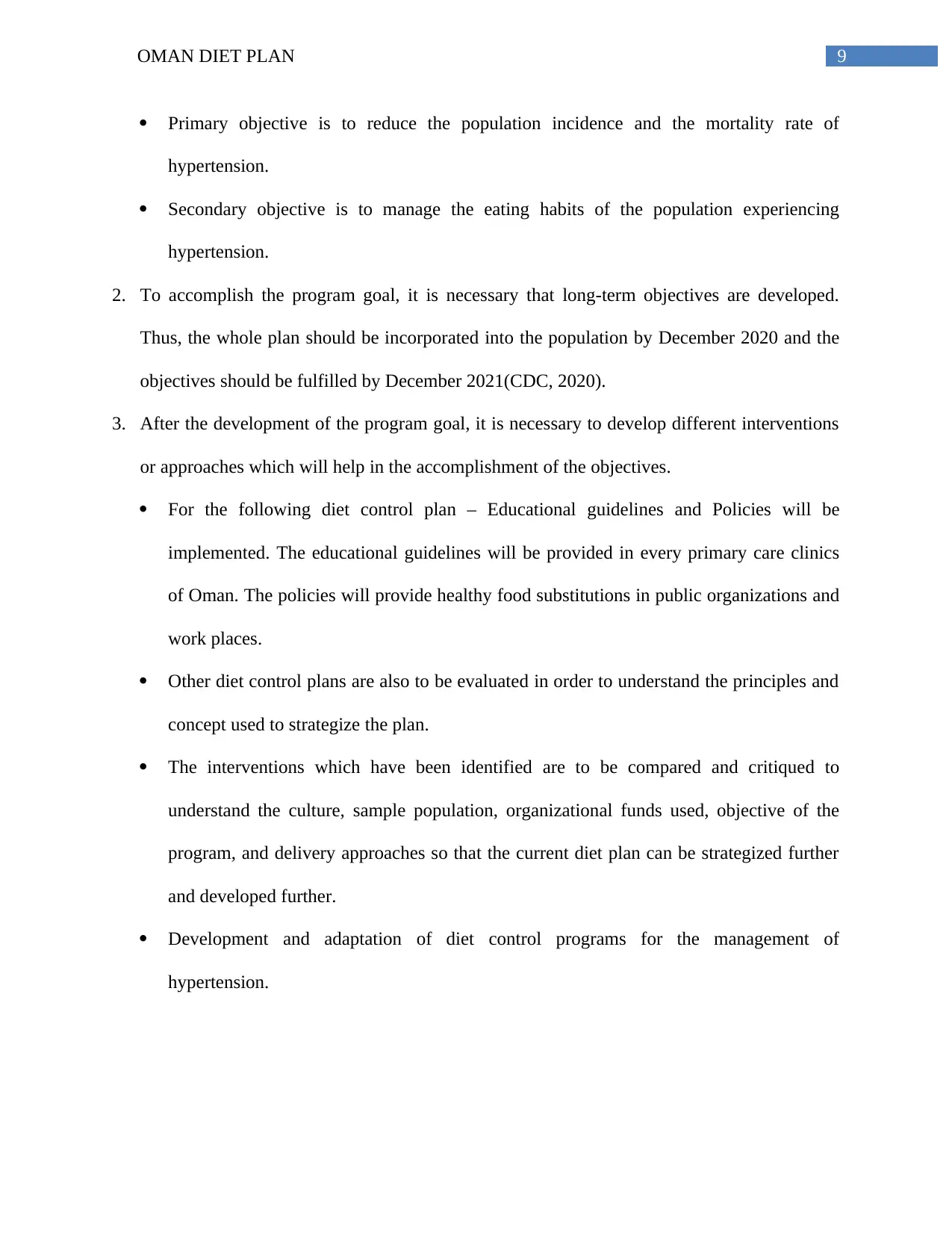
9OMAN DIET PLAN
Primary objective is to reduce the population incidence and the mortality rate of
hypertension.
Secondary objective is to manage the eating habits of the population experiencing
hypertension.
2. To accomplish the program goal, it is necessary that long-term objectives are developed.
Thus, the whole plan should be incorporated into the population by December 2020 and the
objectives should be fulfilled by December 2021(CDC, 2020).
3. After the development of the program goal, it is necessary to develop different interventions
or approaches which will help in the accomplishment of the objectives.
For the following diet control plan – Educational guidelines and Policies will be
implemented. The educational guidelines will be provided in every primary care clinics
of Oman. The policies will provide healthy food substitutions in public organizations and
work places.
Other diet control plans are also to be evaluated in order to understand the principles and
concept used to strategize the plan.
The interventions which have been identified are to be compared and critiqued to
understand the culture, sample population, organizational funds used, objective of the
program, and delivery approaches so that the current diet plan can be strategized further
and developed further.
Development and adaptation of diet control programs for the management of
hypertension.
Primary objective is to reduce the population incidence and the mortality rate of
hypertension.
Secondary objective is to manage the eating habits of the population experiencing
hypertension.
2. To accomplish the program goal, it is necessary that long-term objectives are developed.
Thus, the whole plan should be incorporated into the population by December 2020 and the
objectives should be fulfilled by December 2021(CDC, 2020).
3. After the development of the program goal, it is necessary to develop different interventions
or approaches which will help in the accomplishment of the objectives.
For the following diet control plan – Educational guidelines and Policies will be
implemented. The educational guidelines will be provided in every primary care clinics
of Oman. The policies will provide healthy food substitutions in public organizations and
work places.
Other diet control plans are also to be evaluated in order to understand the principles and
concept used to strategize the plan.
The interventions which have been identified are to be compared and critiqued to
understand the culture, sample population, organizational funds used, objective of the
program, and delivery approaches so that the current diet plan can be strategized further
and developed further.
Development and adaptation of diet control programs for the management of
hypertension.
Paraphrase This Document
Need a fresh take? Get an instant paraphrase of this document with our AI Paraphraser
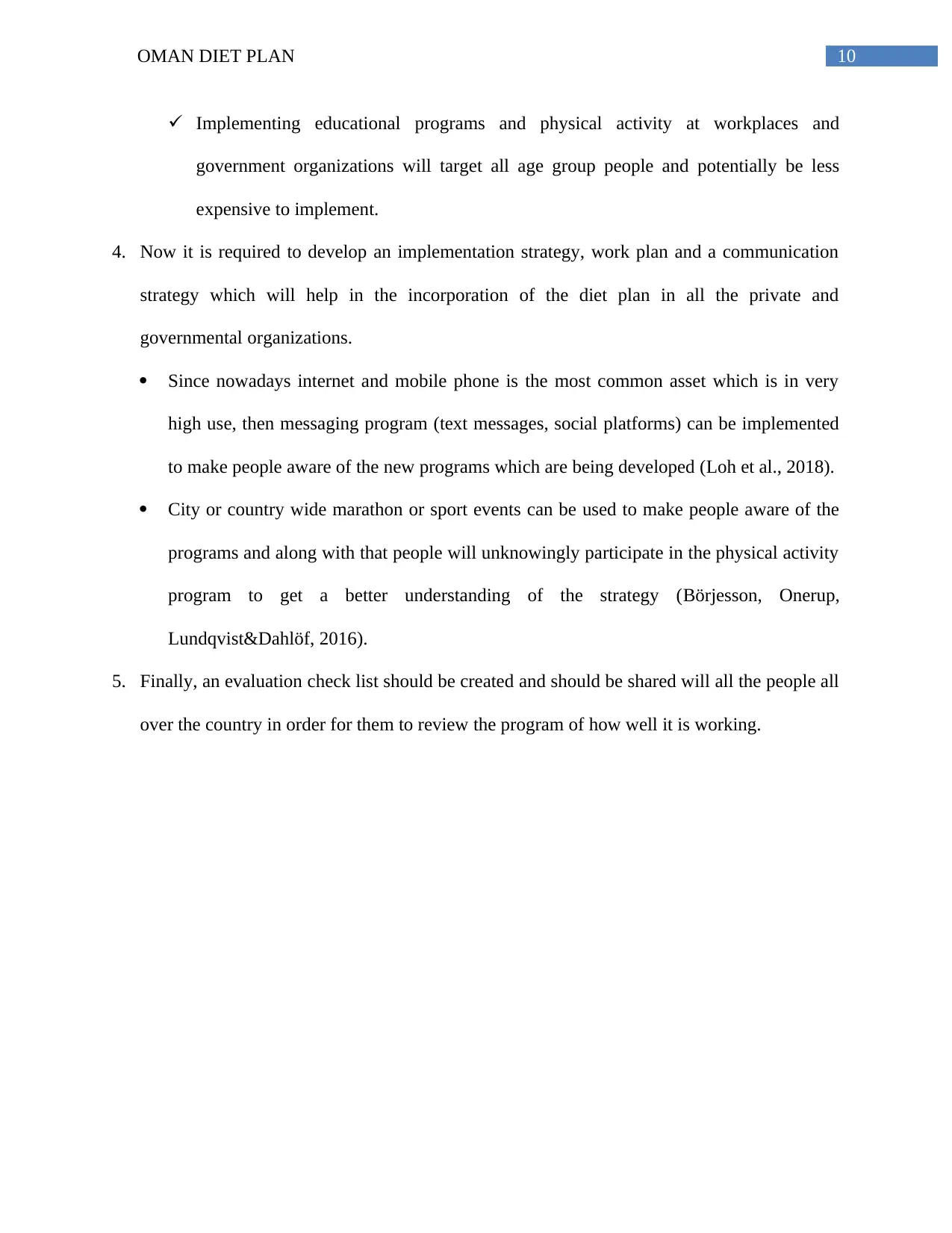
10OMAN DIET PLAN
Implementing educational programs and physical activity at workplaces and
government organizations will target all age group people and potentially be less
expensive to implement.
4. Now it is required to develop an implementation strategy, work plan and a communication
strategy which will help in the incorporation of the diet plan in all the private and
governmental organizations.
Since nowadays internet and mobile phone is the most common asset which is in very
high use, then messaging program (text messages, social platforms) can be implemented
to make people aware of the new programs which are being developed (Loh et al., 2018).
City or country wide marathon or sport events can be used to make people aware of the
programs and along with that people will unknowingly participate in the physical activity
program to get a better understanding of the strategy (Börjesson, Onerup,
Lundqvist&Dahlöf, 2016).
5. Finally, an evaluation check list should be created and should be shared will all the people all
over the country in order for them to review the program of how well it is working.
Implementing educational programs and physical activity at workplaces and
government organizations will target all age group people and potentially be less
expensive to implement.
4. Now it is required to develop an implementation strategy, work plan and a communication
strategy which will help in the incorporation of the diet plan in all the private and
governmental organizations.
Since nowadays internet and mobile phone is the most common asset which is in very
high use, then messaging program (text messages, social platforms) can be implemented
to make people aware of the new programs which are being developed (Loh et al., 2018).
City or country wide marathon or sport events can be used to make people aware of the
programs and along with that people will unknowingly participate in the physical activity
program to get a better understanding of the strategy (Börjesson, Onerup,
Lundqvist&Dahlöf, 2016).
5. Finally, an evaluation check list should be created and should be shared will all the people all
over the country in order for them to review the program of how well it is working.
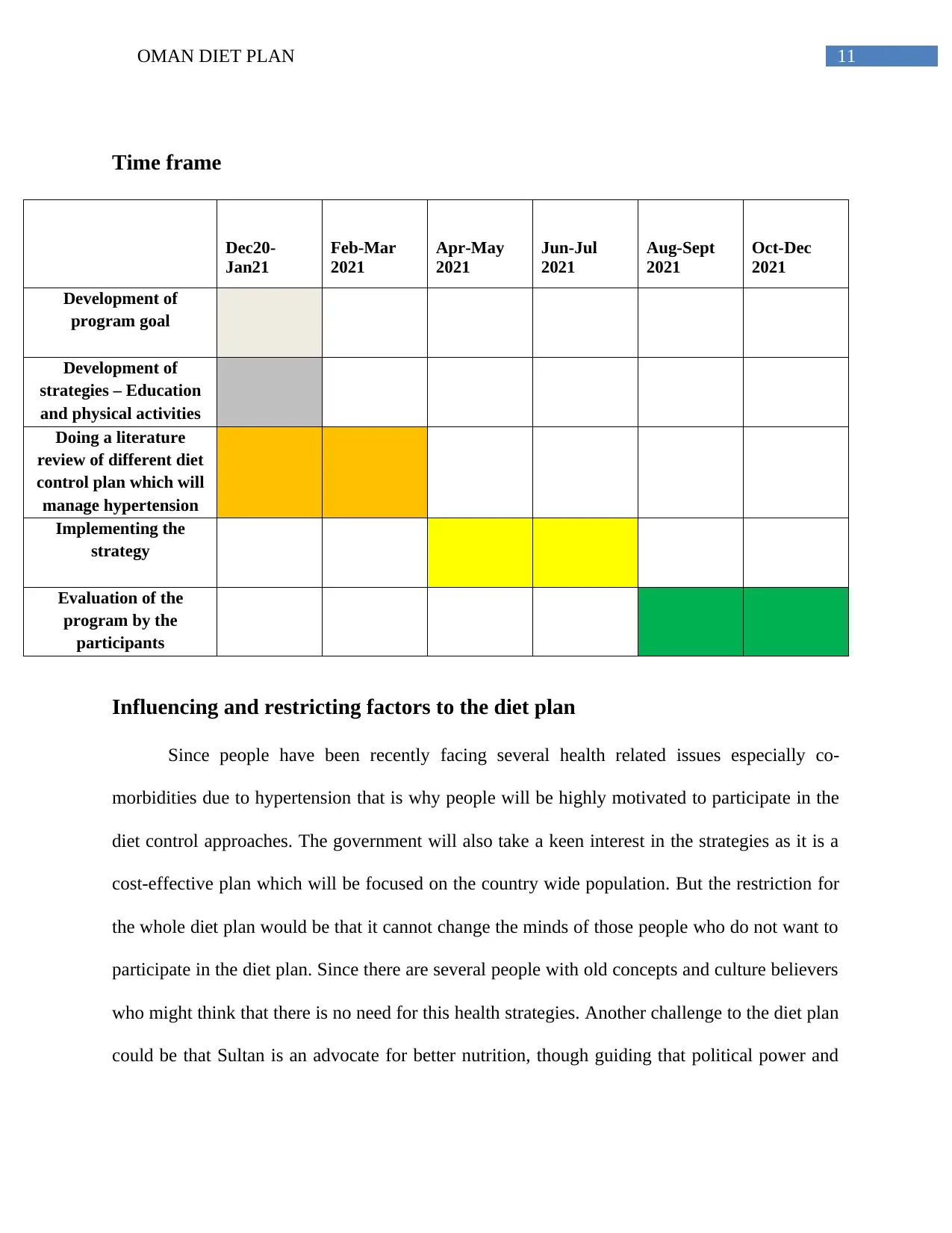
11OMAN DIET PLAN
Time frame
Dec20-
Jan21
Feb-Mar
2021
Apr-May
2021
Jun-Jul
2021
Aug-Sept
2021
Oct-Dec
2021
Development of
program goal
Development of
strategies – Education
and physical activities
Doing a literature
review of different diet
control plan which will
manage hypertension
Implementing the
strategy
Evaluation of the
program by the
participants
Influencing and restricting factors to the diet plan
Since people have been recently facing several health related issues especially co-
morbidities due to hypertension that is why people will be highly motivated to participate in the
diet control approaches. The government will also take a keen interest in the strategies as it is a
cost-effective plan which will be focused on the country wide population. But the restriction for
the whole diet plan would be that it cannot change the minds of those people who do not want to
participate in the diet plan. Since there are several people with old concepts and culture believers
who might think that there is no need for this health strategies. Another challenge to the diet plan
could be that Sultan is an advocate for better nutrition, though guiding that political power and
Time frame
Dec20-
Jan21
Feb-Mar
2021
Apr-May
2021
Jun-Jul
2021
Aug-Sept
2021
Oct-Dec
2021
Development of
program goal
Development of
strategies – Education
and physical activities
Doing a literature
review of different diet
control plan which will
manage hypertension
Implementing the
strategy
Evaluation of the
program by the
participants
Influencing and restricting factors to the diet plan
Since people have been recently facing several health related issues especially co-
morbidities due to hypertension that is why people will be highly motivated to participate in the
diet control approaches. The government will also take a keen interest in the strategies as it is a
cost-effective plan which will be focused on the country wide population. But the restriction for
the whole diet plan would be that it cannot change the minds of those people who do not want to
participate in the diet plan. Since there are several people with old concepts and culture believers
who might think that there is no need for this health strategies. Another challenge to the diet plan
could be that Sultan is an advocate for better nutrition, though guiding that political power and
⊘ This is a preview!⊘
Do you want full access?
Subscribe today to unlock all pages.

Trusted by 1+ million students worldwide
1 out of 17
Related Documents
Your All-in-One AI-Powered Toolkit for Academic Success.
+13062052269
info@desklib.com
Available 24*7 on WhatsApp / Email
![[object Object]](/_next/static/media/star-bottom.7253800d.svg)
Unlock your academic potential
Copyright © 2020–2025 A2Z Services. All Rights Reserved. Developed and managed by ZUCOL.





